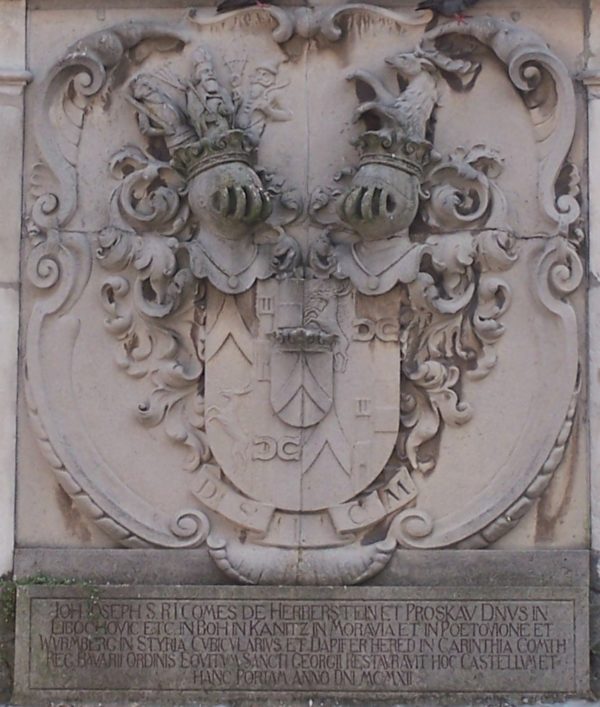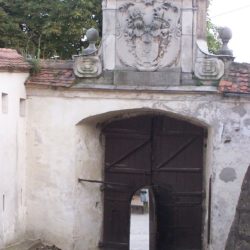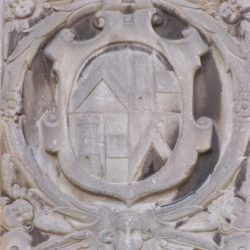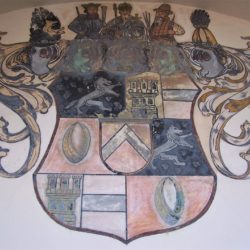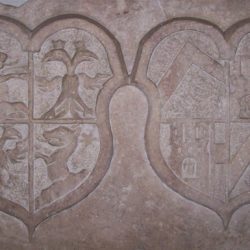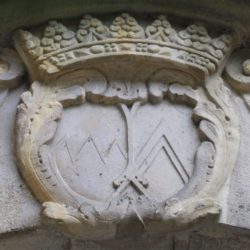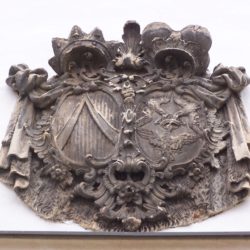
Marshalled coat of arms Herberstein-Proskau in Ptuj Castle
PTUJ, CASTLE
Location of the coat of arms: attic
At the end of the nineteenth century, Ptuj Castle (Pettau), one of the marvels of Slovenian castle architecture and noble heritage in Slovenia, experienced a new period of prosperity, thanks to its owner, Johann Josef Count von Herberstein (1854–1944), who inherited it from his mother Theresa (1822–1895), one of the last members of the princely Dietrichstein family. A very entrepreneurial woman, as soon as the complications regarding castle inheritance and ownership were resolved, Theresa immediately embarked on its thorough remodeling in 1873. The work was brought to completion by Johann Josef Herberstein, her only son, in the early twentieth century. In memory of the restoration, he had the following inscription carved: IOH. IOSEPH S. R. I. COMES DE HERBERSTEIN ET PROSKAV DNVS IN / LIBOCHOVIC ETC. IN BOH. IN KANITZ IN MORAVIA ET IN POETOVIONE ET / WVRMBERG IN STYRIA CVBICVLARIVS ET DAPIFER HERED. IN CARINTHIA COMTH. / REG. BAVARII ORDINIS EQVITVM SANCTI GEORGII RESTAVRAVIT HOC CASTELLVM ET / HANC PORTAM ANNO DNI MCMXII. The inscription and the Herberstein coat of arms can still be seen on the interior side of the pediment of the entrance to the castle courtyard (the pediment’s exterior side is graced by the coat of arms of Count Walter von Leslie from the seventeenth century).
As the inscription reveals, Johann Josef von Herberstein was a chamberlain and hereditary pantler in Carinthia, the commander (Germ. Komtur) of the Royal Order of St. George, and the owner of Ptuj and Vurberk (Wurmbach) in Styria, Libochovice (Libochowitz) in Bohemia, and Dolní Kounice (Kanitz) in Moravia. High revenues from his Bohemian estates allowed him to purchase two other estates in Styria beside Vurberk, that is, Hrastovec (Gutenhag) and Ravno Polje (Ebensfeld). He transferred most of the lavish furnishings from the above-mentioned castles to Ptuj Castle, in which he built a veritable private museum collection and made it open to public. Johann Josef financially supported and organized numerous archaeological excavations in Ptuj and its wider surroundings. It is to his credit that the grave plaque of Friedrich of Pettau, which he stumbled upon in a stable, has been preserved to present day. In 1910, he was awarded honorary membership of the Ptuj museum association for his merit in investigating the town history.
One of many eccentricities that underlined Johann Josef Count von Herberstein’s fascinating life was a markedly different coat of arms from that used by the rest of the Herberstein family, which is yet another story related to his mother Theresa and her ancestors, respectively. In 1693, Karoline Maximiliane Countess von Proskau (Czech: Pruskovská z Pruskova) married Walther, 4th Prince of Dietrichstein. The bride was the last representative of the old Silesian lineage, whose founder, as the legend goes, invented the horseshoe in the time of Alexander the Great and earned himself eternal praise from the famous military commander. In order to prevent the name of such an eminent lineage from fading into obscurity, the descendants of Walther Dietrichstein and Karoline Maximiliane Proskau were given the dual name Dietrichstein-Proskau. However, no more than a century and a half later (in 1858), this lineage too became extinct with the death of Josef, 9th Prince of Dietrichstein. One of the daughters of the late prince was Theresa, married Countess von Herberstein, who, among other things, passed on to her only son Johann Josef the monetary fideicommissum of her ancestors, the Counts Proskau. Based on the said fideicommissum, the emperor authorized Johann Josef in 1896 to combine his name and coat of arms with those of the Proskau family. The same right was to be exercised by all his descendants appointed as fideicommissary heirs. Thenceforth, Johann Josef’s official name was Count Herberstein and Proskau, and his Herberstein coat of arms was expanded by incorporating a deer and a pair of horseshoes from the Proskau coat of arms.
Interestingly, the depictions of the Herberstein-Proskau coat of arms produced in Johann Josef’s time differ from the official blazon. The Proskau deer and horseshoes are in the bisected second and third quarters, and the original Herberstein milvus, the tower of Castile, and the Austrian silver log against the red background are “crammed” into the first and the fourth quarters. There are likewise only two helmets, with three rulers rising from the dexter helmet and a deer rising from the sinister helmet. It is not entirely clear why Johann Josef used this smaller, stylized coat of arms; perhaps the official version was too complex. According to his grandson, Christoph Herberstein, he also seems to have planned to use this form of arms on his cutlery.
The abolition of fideicommissa after the First World War also spelled the end to the monetary fideicommissum of the Counts Proskau. Today, the Herbersteins no longer bear the dual name, and the expanded Herberstein-Proskau coat of arms has all but fallen into oblivion.
Sources:
Ciglenečki, Marjeta: Družini Leslie in Herberstein ter oprema njihovih gradov Hrastovec, Vurberg in Ptuj. Srečanje z Jutrovim na Ptujskem gradu. Ptuj, 1992, pp. 43–52.
Meraviglia Crivelli, Rudolf Johann: Der Böhmische Adel. J. Siebmachers grosses und allgemeines Wappenbuch, 4. Bd. 9. Abt. Nürnberg, 1886, p. 157.
Ptuj, castle
Grad Ptuj, Na Gradu, Ptuj, SlovenijaOther coats of arms of the Herberstein
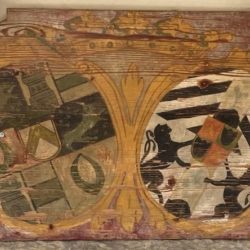
Arms of alliance of the Herberstein and Pölheim families in Lenart
Lenart v Slovenskih goricah
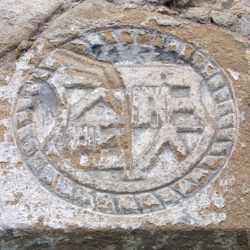
Coat of arms of the Herberstein family near Hrastovec Castle
Lenart v Slovenskih goricah
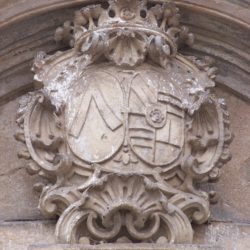
Arms of alliance of the Counts Herberstein and Trauttmansdorff in Hrastovec Castle
Lenart v Slovenskih goricah

Coat of arms of the Counts Herberstein in Hrastovec Castle
Lenart v Slovenskih goricah
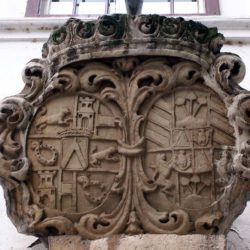
Arms of alliance of the Counts Herberstein and Saurau in Hrastovec Castle
Lenart v Slovenskih goricah
